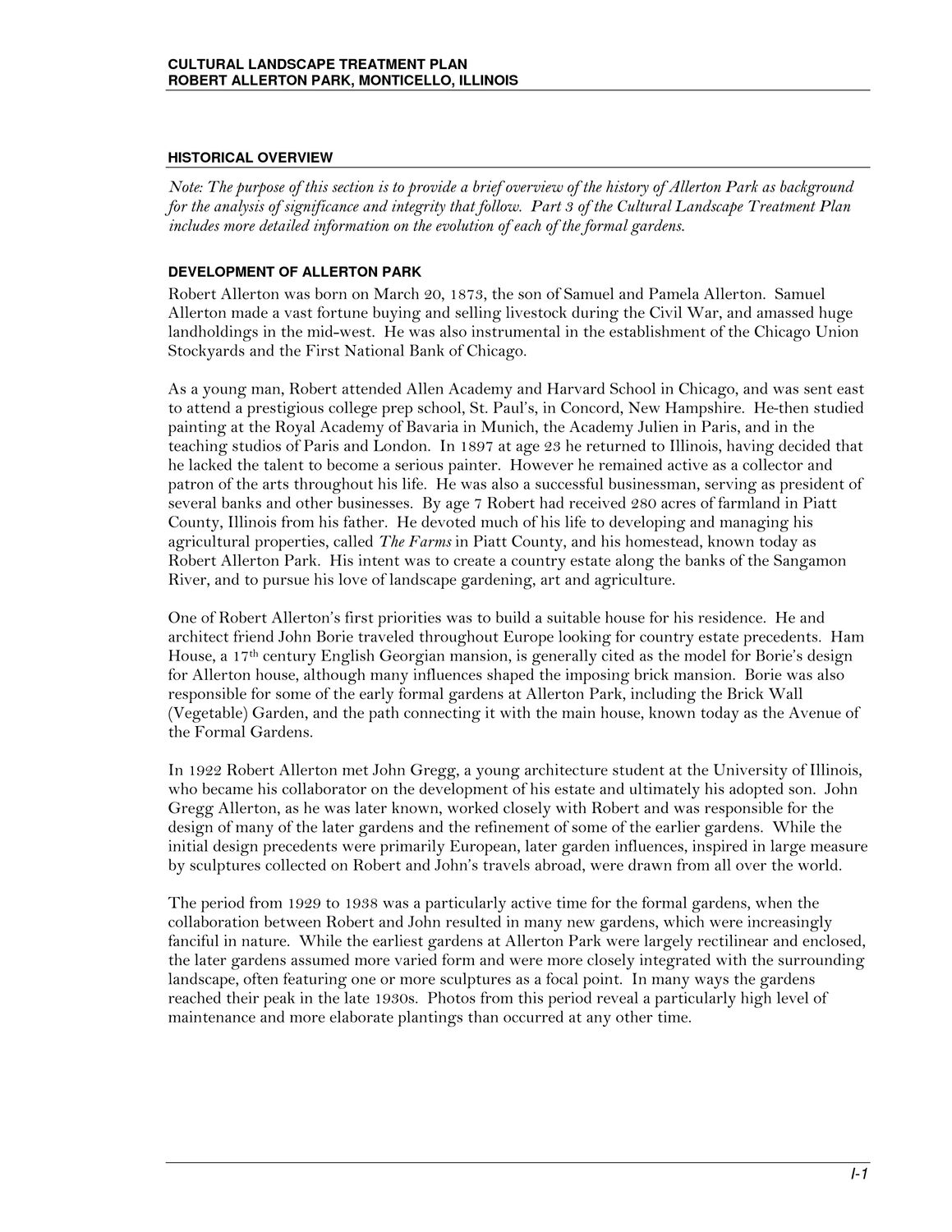| |
| |
Caption: Map of UIUC (2001) (Allerton)
This is a reduced-resolution page image for fast online browsing.

EXTRACTED TEXT FROM PAGE:
CULTURAL LANDSCAPE TREATMENT PLAN ROBERT ALLERTON PARK, MONTICELLO, ILLINOIS HISTORICAL OVERVIEW Note: The purpose of this section is to provide a brief overview of the history of Allerton Park as background for the analysis of significance and integrity that follow. Part 3 of the Cultural Landscape Treatment Plan includes more detailed information on the evolution of each of the formal gardens. DEVELOPMENT OF ALLERTON PARK Robert Allerton was born on March 20, 1873, the son of Samuel and Pamela Allerton. Samuel Allerton made a vast fortune buying and selling livestock during the Civil War, and amassed huge landholdings in the mid-west. He was also instrumental in the establishment of the Chicago Union Stockyards and the First National Bank of Chicago. As a young man, Robert attended Allen Academy and Harvard School in Chicago, and was sent east to attend a prestigious college prep school, St. Paul’s, in Concord, New Hampshire. He then studied painting at the Royal Academy of Bavaria in Munich, the Academy Julien in Paris, and in the teaching studios of Paris and London. In 1897 at age 23 he returned to Illinois, having decided that he lacked the talent to become a serious painter. However he remained active as a collector and patron of the arts throughout his life. He was also a successful businessman, serving as president of several banks and other businesses. By age 7 Robert had received 280 acres of farmland in Piatt County, Illinois from his father. He devoted much of his life to developing and managing his agricultural properties, called The Farms in Piatt County, and his homestead, known today as Robert Allerton Park. His intent was to create a country estate along the banks of the Sangamon River, and to pursue his love of landscape gardening, art and agriculture. One of Robert Allerton’s first priorities was to build a suitable house for his residence. He and architect friend John Borie traveled throughout Europe looking for country estate precedents. Ham House, a 17th century English Georgian mansion, is generally cited as the model for Borie’s design for Allerton house, although many influences shaped the imposing brick mansion. Borie was also responsible for some of the early formal gardens at Allerton Park, including the Brick Wall (Vegetable) Garden, and the path connecting it with the main house, known today as the Avenue of the Formal Gardens. In 1922 Robert Allerton met John Gregg, a young architecture student at the University of Illinois, who became his collaborator on the development of his estate and ultimately his adopted son. John Gregg Allerton, as he was later known, worked closely with Robert and was responsible for the design of many of the later gardens and the refinement of some of the earlier gardens. While the initial design precedents were primarily European, later garden influences, inspired in large measure by sculptures collected on Robert and John’s travels abroad, were drawn from all over the world. The period from 1929 to 1938 was a particularly active time for the formal gardens, when the collaboration between Robert and John resulted in many new gardens, which were increasingly fanciful in nature. While the earliest gardens at Allerton Park were largely rectilinear and enclosed, the later gardens assumed more varied form and were more closely integrated with the surrounding landscape, often featuring one or more sculptures as a focal point. In many ways the gardens reached their peak in the late 1930s. Photos from this period reveal a particularly high level of maintenance and more elaborate plantings than occurred at any other time. I-1
| |